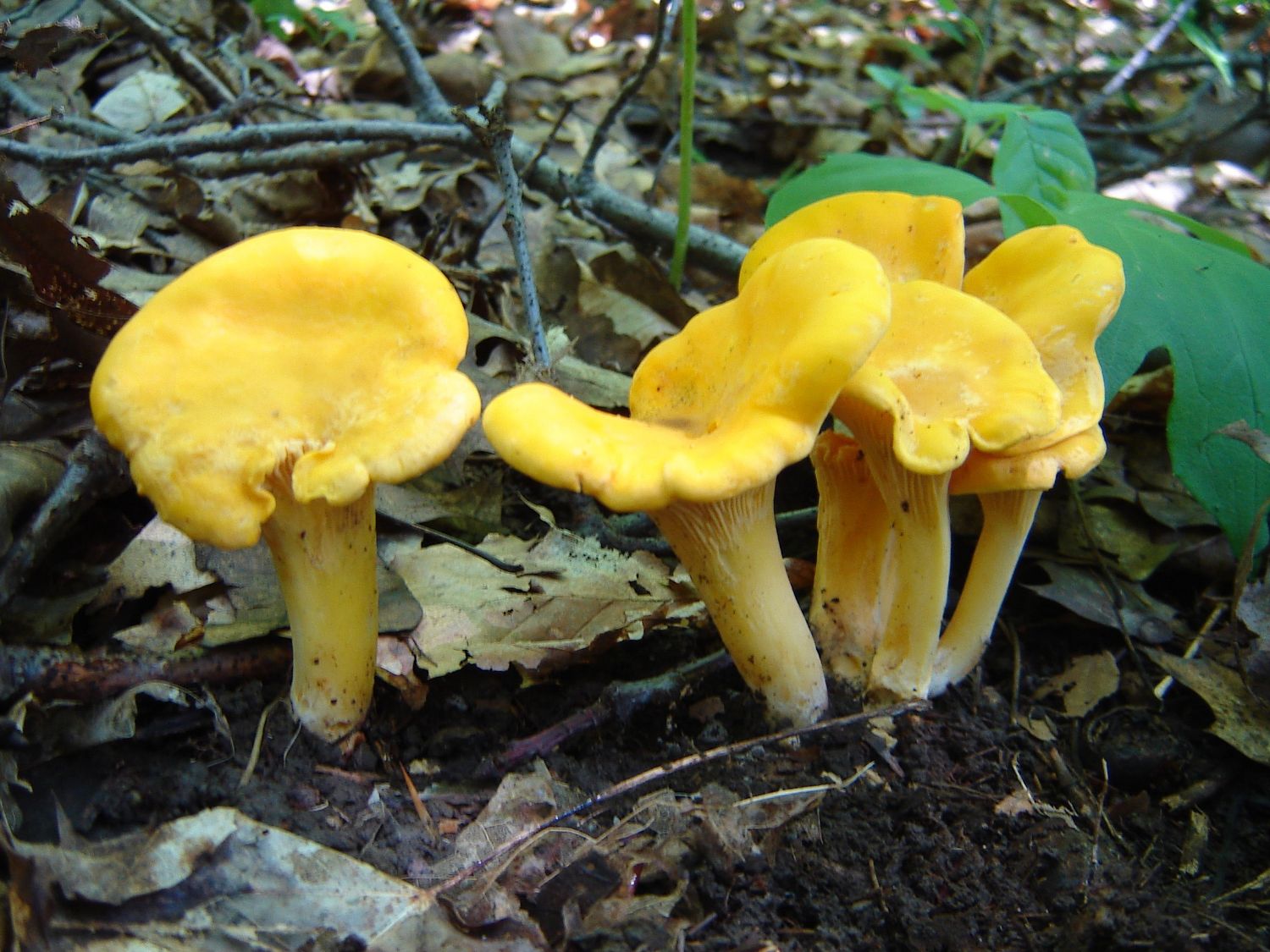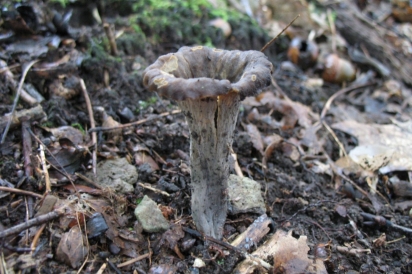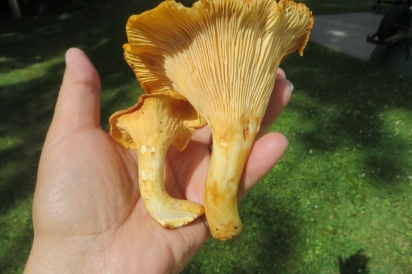Adventures in Search of Wild Gourmet Mushrooms
HOW I LEARNED
I learned mushroom hunting in the woods of Normandy, France, with my French wife's kid brothers. Their father was a lumberjack during World War II who trained them well. Patrick and Jean-Marc were ages 9 and 11 at the time. After a rain, we would rush to rise before dawn, in order to get ahead of the many other people hunting for mushrooms in the woods. And there was a lot of competition. We all searched for the prize gourmet mushrooms: golden chanterelles and black trumpets, which must be hunted in the wild. Unlike white button mushrooms, they cannot be grown commercially. I was surprised how the taste of these mushrooms differed from those commonly found in supermarkets. Much like vegetables, various species of mushrooms offer diverse tastes and textures.
MYCOPILIC AND MYCOPHOBIC CULTURES
Lee Peterson, naturalist and author of the guidebook Edible Wild Plants, once told me that he believed the world is divided into mushroom-loving people and those who hate mushrooms. France has a cultural tradition in which wild edible mushrooms are highly valued and sought after. Theirs is what's called a mycophilic culture, unlike cultures that are mycophobic, in which people fear and avoid wild mushrooms. Visit a Chinese grocery store and you can see that all the dried mushrooms provide evidence of a mycophilic culture. On the other hand, examples of a mycophobic tradition can found in England and Anglo-American culture.
However, that Anglo tradition is changing fast, perhaps due to the influence of cuisines from mushroom-loving cultures, such as those from Northern Italy, Eastern Europe and Asia. Witness the popularity of Italian portabellas and Japanese shiitakes. Descendants of Eastern European Jewish immigrants are familiar with mushroom barley soup, originally made with wild Boletus edulis mushrooms (called porcini in Italy, ceps in France).
Hunting for wild mushrooms is familiar to many rural people in the Midwest who search for morels in early spring. However, many mushroom hunters are expanding their palate, seeking the same ones I looked for in France: golden chanterelles and black trumpets. These varieties are the most commonly sought after for French family cooking, and may be found in fine French restaurants throughout the U.S.
A TRUNK FALL OF CHANTERELLES
One rainy summer, my wife and I collected a huge amount of beautiful apricot-colored chanterelles, put them in baskets in the trunk of our car and took them with us to a church picnic to give away as gifts. No one wanted any. My friends looked at them in fear. Some asked if I was sure that they were not poisonous. (Strange orange mushrooms!) All except one personan elderly friend who grew up in Sweden. He looked with amazement at the trunk filled with chanterelles. He said he did not know that pfferlings (the German word for them) could be found in our country.
EXCHANGING CHANTERELLES FOR FRENCH CUISINE
Fortunately, there are restaurant chefs who know about and value chanterelles. In rainy summers when we could find a surplus of chanterelles, we took them to French restaurants and exchanged them for meals. We just didn't want them to go to waste. (Yes, we also cooked and froze a lot for use in winter.) One experience was especially memorable.
There was an excellent French restaurant called La Fleur outside of the Chautauqua Institution near where we live. It has since closed. We knew the young French chef, and we knew that his restaurant advertised that it primarily sourced fresh local products. So, we asked him if he was interested in chanterelles, should we find a surplus. One day, my wife and I took a large basketful to him. We exchanged the mushrooms for two special five-course meals (accompanied by five different wines).
The evening we arrived for our dinners, we sat next to a couple from New York City, and chatted a bit. Later, they asked the chef where he was able to get local chanterelles, and he pointed to us. What an interesting coincidence. The couple was Tim and Nina Zagat, and they were sampling the restaurant for their famous Zagat rating. La Fleur subsequently received the highest possible Zagat rating. We thought that maybe our mushrooms helped a little bit.
A CASE OF MUSHROOM POISONING
I don't take a lot of risks in mushroom hunting, because I am well aware that mistakes can be made and some species are poisonous, or even deadly. And though I love good food, I have a sensitive digestive system. I stick mainly to the gourmet mushrooms already mentioned, although I have tried others. Some taste to me like cardboard, some are relatively flavorless (like giant puffballs) and others have a disagreeable chewy texture. I can identify the common poisonous varieties, and I know the ones with nerve poison that have killed unlucky people.
Once, a hospital called me to help doctors identify some mushrooms that had caused serious poisoning. Earlier, a worried friend of my wife had asked her to identify some mushrooms that were found by a relative. When my wife saw the mushrooms, she warned the fellow not to eat his prized mushrooms, because they were poisonous. He believed that they were very large chanterelles, but they were actually poisonous jack-o-lantern mushrooms. He thought that she was merely jealous of his treasure, so he stubbornly cooked them for himself and a friend for dinner.
Later that evening, we got a telephone call from a doctor at the local hospital, asking us to identify the species of mushroom that my wife had seen with the now seriously ill patient. He recovered with proper treatment. But he didn't tell his friend, whom he had invited for dinner, perhaps out of embarrassment. The dinner guest spent about a week recovering in the hospital. Fortunately, the poison was gastrointestinal and not a nerve poison, or the two would have been dead by the time its effects were felt.
TAKE TIME TO LEARN
It is fun to get out in the woods and gather food to eat. Remember picking wild blueberries? But learning how to identify edible mushrooms is like learning how to make electrical repairs in your home: be careful. Don't believe any of the folk wisdom about wild mushrooms. The best way to begin is to learn with someone who is very experienced. Buy several mushroom guidebooks, ideally with numerous photos. Focus on only one or two species at first. Note subtle differences among species, in order to avoid mistakes. Finally, learn how to cook them properly usually slowly, with some shallots and garlic. Bon appetit!










